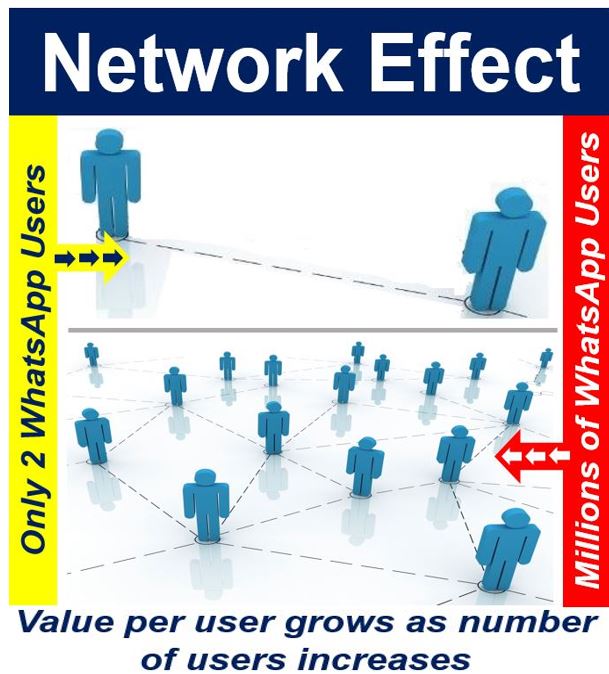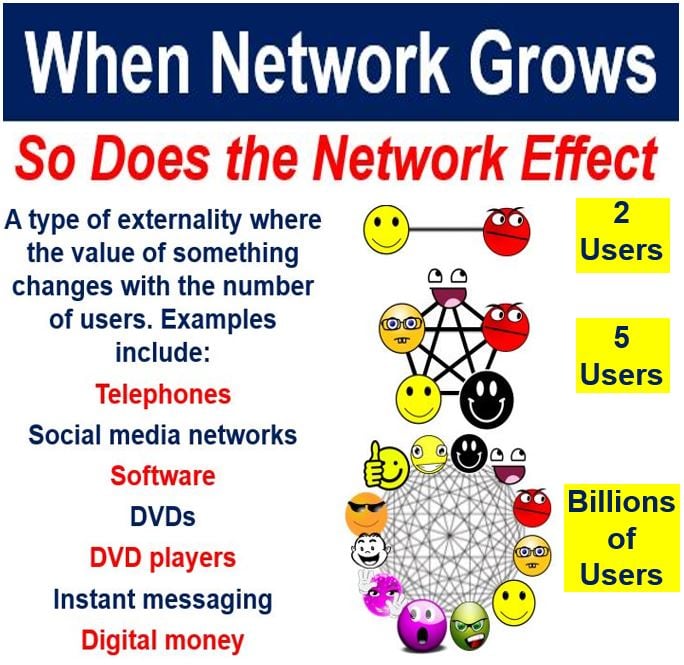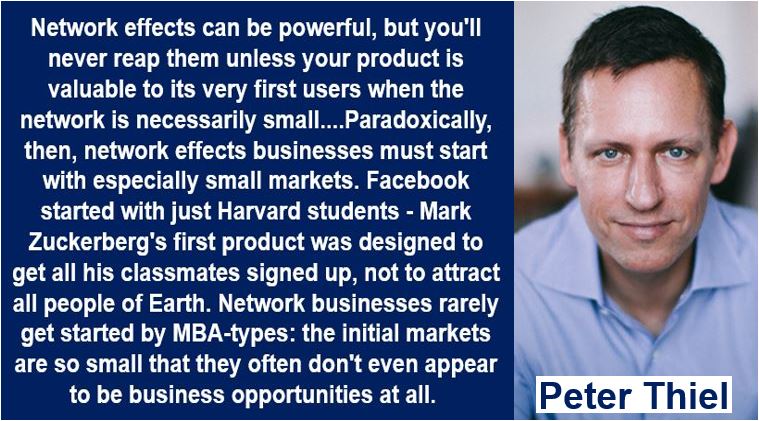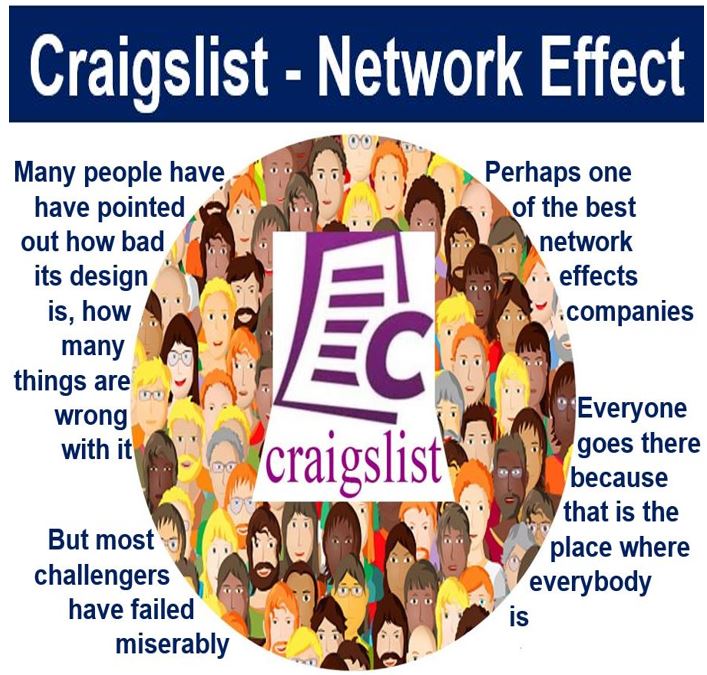The network effect refers to how the value of something to a consumer changes when the number of other people also using it changes. For example, owning a smartphone becomes considerably more valuable as the number of customers plugged into the telephone network grows. Put simply, it is a phenomenon in which a good or service gains additional value as more consumers use it. (Good = Product)
Technically, the term refers to the effect that one individual user of a product or service has on the value of that product or service to other people. When a network effect exists, the value of a good or service depends on the numbers of others using it.
The network effect, which is also called network externality or demand-side economies of scale, can be clearly observed in social networks. A social networking site is more valuable for its subscribers as more people sign up to it.
 If WhatsApp only had two subscribers, its value for each user would be virtually zero. According to statista.com, today, the text, voice and video freeware messenger app for smartphones has more than 1 billion users. The network effect present in Whatsapp is massive.
If WhatsApp only had two subscribers, its value for each user would be virtually zero. According to statista.com, today, the text, voice and video freeware messenger app for smartphones has more than 1 billion users. The network effect present in Whatsapp is massive.
Network effect example – the Internet
When the Internet first started there were not many users, so it had relatively negligible value to any individual who was not in the military or working in a research laboratory.
As more people went online, however, the number of websites one could visit grew, and there were more people to get in touch with.
As soon as hundreds of millions and then billions of humans had Internet access globally, it became extremely valuable to users.
In 1993, the Internet carried just one percent of the information flowing through 2-way telecommunication. By the year 2000, that percentage had jumped to 51%. Two years later (2007), 97% of all telecommunication data was carried over the Internet.
 In order to become commercially viable or successful, most online products and services are dependent on a healthy network effect.
In order to become commercially viable or successful, most online products and services are dependent on a healthy network effect.
The growth of Internet usage from 1993 to 2007 – a period of just 14 years – was unprecedented. The network effect was astonishing.
According to InternetWorldStats.com, there were 16 million Internet users globally in 1995. By December 2000, there were more than 361 million. Ten years later, in 2010, a staggering 1.971 billion had access to the Internet. By September 2016, the total had reached 3.675 billion.
Benefits of the network effect
Network effects become statistically significant when a number or percentage of subscribers is reached – known as the critical mass. At this point, the value obtained from the product or service is at least equivalent to the price the user paid for it.
As more people use the product or subscribe to a service, its value continues to grow in comparison to what users paid for it.
A company’s biggest challenge is finding a way to attract users before it reaches that critical mass. Some businesses offer a fee waiver, try to encourage subscribers to get friends to sign up, or even offer incentives to get people to attract new users.
Ideally, the supplier should have built a system that already has enough value without networking effects – at least for the initial users. Then, as the number of users grows, the system’s value grows even more and it is able to attract a broader user base.
 Peter Thiel – known as the ‘Don of the PayPal Mafia’ – is a German-American-New Zealand entrepreneur, venture capitalist, hedge-fund manager, political activist, author, and philanthropist. He was ranked fourth on the 2014 Forbes Midal List, with a net worth of $2.2 billion. 2016 Forbes 400 placed him 246nd, with a net worth of $2.7 billion. (Image: thielfoundation.org/peter)
Peter Thiel – known as the ‘Don of the PayPal Mafia’ – is a German-American-New Zealand entrepreneur, venture capitalist, hedge-fund manager, political activist, author, and philanthropist. He was ranked fourth on the 2014 Forbes Midal List, with a net worth of $2.2 billion. 2016 Forbes 400 placed him 246nd, with a net worth of $2.7 billion. (Image: thielfoundation.org/peter)
Negative network effect
Not all network effects are positive – there are also negative ones. If too many people sign up and the company has trouble coping, there could be congestion – which for online services generally means that the whole things slows down, which in turn decreases utility for users. A long-term slowdown of a website is the equivalent of giving it the kiss of death.
Providers of products and services which benefit from a network effect need to make sure that they are able to increase capacity enough to accommodate all the growing number of users.
 One of the biggest mistakes when setting up a purely online service, is to focus on the tech bells and whistles, rather than building up the numbers of users. Craigslist has a very simple, 1990s-type look about it – but it has a huge following, i.e. the network effect is strong. It is mostly a question of numbers.
One of the biggest mistakes when setting up a purely online service, is to focus on the tech bells and whistles, rather than building up the numbers of users. Craigslist has a very simple, 1990s-type look about it – but it has a huge following, i.e. the network effect is strong. It is mostly a question of numbers.
In some cases, congestion is impossible. Imagine a new language – LinguaTerra – was invented, but nobody spoke it. Whoever decided to learn it would not find it very useful, because nobody else spoke Terra-Lingua.
However, if after five years, 10 million people spoke it, the network effect would be significant. No matter how many people learnt Terra-Lingua – 1 billion or everybody on Earth – there would never be congestion regarding the language’s usage.
How the network always wins
In this InnoTribe video, the speakers talk about the network effects in today’s environment of fast speed and enormous scale.
